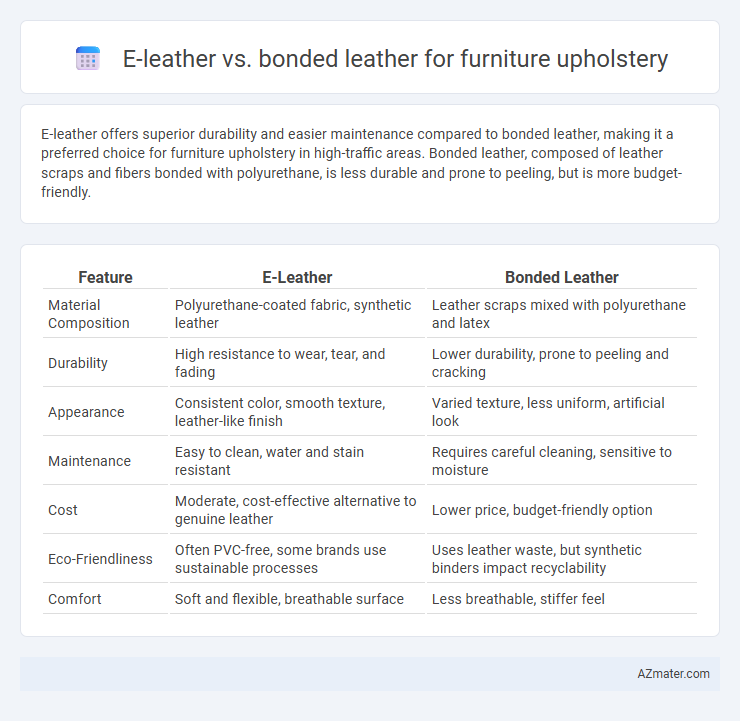E-leather offers superior durability and easier maintenance compared to bonded leather, making it a preferred choice for furniture upholstery in high-traffic areas. Bonded leather, composed of leather scraps and fibers bonded with polyurethane, is less durable and prone to peeling, but is more budget-friendly.
Table of Comparison
| Feature | E-Leather | Bonded Leather |
|---|---|---|
| Material Composition | Polyurethane-coated fabric, synthetic leather | Leather scraps mixed with polyurethane and latex |
| Durability | High resistance to wear, tear, and fading | Lower durability, prone to peeling and cracking |
| Appearance | Consistent color, smooth texture, leather-like finish | Varied texture, less uniform, artificial look |
| Maintenance | Easy to clean, water and stain resistant | Requires careful cleaning, sensitive to moisture |
| Cost | Moderate, cost-effective alternative to genuine leather | Lower price, budget-friendly option |
| Eco-Friendliness | Often PVC-free, some brands use sustainable processes | Uses leather waste, but synthetic binders impact recyclability |
| Comfort | Soft and flexible, breathable surface | Less breathable, stiffer feel |
Introduction to E-Leather and Bonded Leather
E-leather, also known as engineered leather, is a synthetic material made by blending genuine leather fibers with polyurethane, offering durability and a soft feel ideal for furniture upholstery. Bonded leather consists of leather scraps and fibers bonded together with adhesives and coated with polyurethane or latex, providing an affordable alternative that mimics leather appearance. While E-leather delivers improved breathability and resistance to cracking compared to bonded leather, both materials offer cost-effective options with varying levels of durability and maintenance requirements.
Material Composition: E-Leather vs Bonded Leather
E-leather, also known as engineered leather, is composed of a polyester base layer coated with a polyurethane finish, offering enhanced durability, breathability, and a more natural leather appearance. Bonded leather is made by shredding genuine leather scraps mixed with polyurethane or latex binders and pressed onto a fiber backing, resulting in lower durability and a less authentic texture. The material composition of E-leather typically ensures better resistance to wear and easier maintenance compared to the fibrous, composite structure of bonded leather used in furniture upholstery.
Manufacturing Processes Compared
E-leather is produced by coating a fabric base with polyurethane, creating a durable, eco-friendly, and vegan alternative that mimics genuine leather's texture. Bonded leather is manufactured by blending shredded leather scraps with polyurethane or latex, resulting in a lower-cost material with inconsistent quality and reduced durability. The manufacturing process of E-leather emphasizes sustainability and uniformity, while bonded leather relies on recycling leather remnants but often sacrifices performance and longevity.
Durability and Longevity
E-leather, a digitally engineered synthetic material, offers superior durability and resistance to wear compared to bonded leather, which consists of leather scraps bonded with polyurethane or latex. The tightly controlled manufacturing process of E-leather ensures enhanced longevity, maintaining appearance and texture over extended use, while bonded leather is prone to cracking and peeling within a few years due to weaker fiber composition. For furniture upholstery, E-leather represents a more durable and longer-lasting option, minimizing the need for frequent replacements and repairs.
Comfort and Softness in Upholstery
E-leather provides superior comfort and softness in furniture upholstery due to its enhanced breathability and flexible texture, closely mimicking genuine leather. Bonded leather, composed of leather scraps mixed with polyurethane, tends to be less breathable and firmer, which can lead to a stiffer and less comfortable seating experience. The durability and cushioning properties of e-leather make it a preferred choice for upholstery aiming to maximize comfort and softness.
Environmental Impact and Sustainability
E-leather, made from polyurethane bonded to natural fibers, offers a more sustainable alternative to bonded leather by reducing reliance on animal hides and minimizing waste through the use of recycled materials. Bonded leather, composed of leather scraps bonded with synthetic materials, often contains higher levels of plastic and adhesives that hinder biodegradability and generate environmental toxins during production and disposal. Choosing E-leather supports lower carbon footprints and promotes circular economy principles, making it a more eco-friendly option for furniture upholstery.
Cost Differences and Value for Money
E-leather typically costs more than bonded leather due to its enhanced durability, water resistance, and eco-friendly manufacturing process. Bonded leather, made from leather scraps bonded with polyurethane, offers a lower upfront price but tends to wear out faster and may peel or crack over time. Investing in e-leather generally delivers better long-term value for furniture upholstery given its longevity and superior appearance retention.
Maintenance and Care Requirements
E-leather requires minimal maintenance due to its synthetic composition, which resists stains and fading, making it easy to clean with a damp cloth and mild soap. Bonded leather demands more frequent care, as its natural leather fibers combined with synthetic materials are prone to cracking and peeling, requiring specialized leather conditioners and gentle cleaning products. Proper maintenance of bonded leather also involves avoiding excessive moisture and direct sunlight to preserve its durability and appearance over time.
Aesthetics and Design Flexibility
E-leather offers superior aesthetics with a smooth, uniform finish that closely mimics genuine leather, providing a sleek and modern appearance ideal for contemporary furniture designs. Bonded leather tends to have a more varied texture due to its composite nature, which can limit design flexibility and may show inconsistencies over time. E-leather supports a wider range of colors and patterns, allowing for greater customization and innovative upholstery styles in furniture manufacturing.
Which is Better for Furniture Upholstery?
E-leather, made from a polyurethane coating bonded to a fabric base, offers superior durability, stain resistance, and ease of maintenance compared to bonded leather, which is composed of leather scraps mixed with adhesives and polyurethane. For furniture upholstery, E-leather provides a more consistent appearance and better longevity, making it a preferred choice for high-traffic areas and daily use. Bonded leather may appear more affordable but tends to wear out faster, peel, and lacks the same level of comfort and resilience as E-leather.

Infographic: E-leather vs Bonded leather for Furniture upholstery
 azmater.com
azmater.com